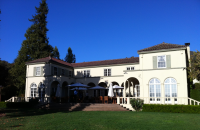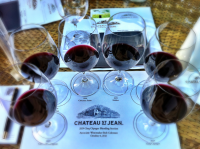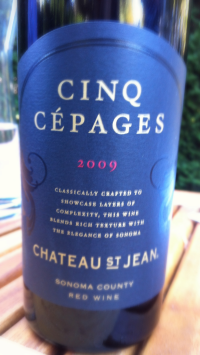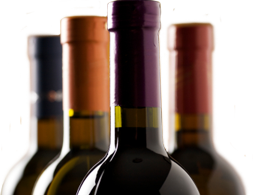Feb 18, 2013

A visit to Chateau St. Jean in California's Sonoma Valley, is not one you'll soon forget.
The stunning estate with its sprawling manicured lawns and gardens are a destination for day tourists, wine country nuptials and receptions.
 The main courtyard is a nod to Mediterranean design with its terracotta pots, central fountain (with a classical statue of Jean - the winery's namesake) and foliage. Off the courtyard, the visitor's center is loaded with treats (perfect for picnicking on the grounds) and wine related housewares, you'll have no problem finding something to take home, in addition to the famous Chateau St. Jean wine. The main courtyard is a nod to Mediterranean design with its terracotta pots, central fountain (with a classical statue of Jean - the winery's namesake) and foliage. Off the courtyard, the visitor's center is loaded with treats (perfect for picnicking on the grounds) and wine related housewares, you'll have no problem finding something to take home, in addition to the famous Chateau St. Jean wine.
The Chateau was initially built as a summer home in 1920 and vines were planted on the estate. However, prohibition put the kaibosh on that and the vines were replaced with fruit and nut trees. When the Chateau St. Jean (pronounced Jean, like your denim pants) winery was established in 1983, the decision was made to restore the estate to its original glory.
 For the past 33 years, chief winemaker Margo Van Staaveren has worked at Chateau St. Jean. Her strength in blending is widely recognized - especially for the internationally acclaimed five-variety blend, Cinq Cépages. It was Wine Spectator's #1 wine in the world in 1996. For the past 33 years, chief winemaker Margo Van Staaveren has worked at Chateau St. Jean. Her strength in blending is widely recognized - especially for the internationally acclaimed five-variety blend, Cinq Cépages. It was Wine Spectator's #1 wine in the world in 1996.
Producing an award winning blend using Cabernet Sauvignon, Cabernet Franc, Merlot, Malbec and Petit Verdot is no easy task. I was put to the test, when I visited last fall and I can attest to its difficulty.
Although I may have been able to drink my own concoctions, (my second attempt was a blend of 65% Cabernet Sauvignon, 15% Merlot, 9% Cabernet Franc, 4% Malbec and 7% Petit Verdot) it was nowhere in the ballpark of the iconic Cinq Cépages.
(My own attempt - five blenders plus the final concoction at right)

The choice of these five traditional Bordelaise varieties is no accident. Van Staavern uses Cabernet Sauvignon for it's concentrated black fruit and structure and Merlot for it's suppleness (think of it rounding out the mid-palate). The Cabernet Franc adds brightness, spice and palate length. Malbec adds high-toned floral aromas and Petit Verdot finalizes the blend with bittersweet chocolate and roasted coffee.
Von Staavern and her team (including Associate Winemaker, Bob Coleman (right), who will be in Vancouver for the upcoming Vancouver International Wine Festival, 2013) harvest grapes from Sonoma Valley, Knight's Valley, Alexander Valley, Dry Creek and Russian River to create the perfect Cinq Cépages blend, which by the way, varies vintage to vintage.
One simply cannot mention Chateau St. Jean without talking about their Pinot Noir. Pinot Noir is not just a specialty of Chateau St. Jean's it's the most important red variety in Sonoma right now - along with it's sister, Chardonnay. Chateau St. Jean makes a range of Pinot Noirs and Chardonnays from various vineyards around Sonoma.
Also included in their portfolio: Syrah, Merlot, Cabernet Franc and Cabernet Sauvignon, Viognier, Fume Blanc and Pinot Blanc.

Tasting Notes
Blending an icon - my Cinq Cépages blending exercise using these five Chateau St. Jean components.
Chateau St. Jean Cabernet Sauvignon, 2009 - Rich cassis and chocolate with incredible intensity and power. Fantastic structure yet generous in the mouth with long sweet tannins.
Chateau St. Jean Merlot, 2009 - Plummy, grapey, wild berries and chocolate, lavender and sweet spice. Good length and bittersweet chocolate finish with a slight tartness.
Chateau St Jean Cabernet Franc, 2009 - Raspberries, vanilla, dried herbs and roasted bell pepper, violets and thyme. Long sweet tannins and cocoa trailing across the finish.
Chateau St. Jean Malbec, 2009 - Typical for this variety, meaty and savoury with grapey, blackberry notes, violets and pepper. Thick and spicy in the mouth with juicy purple fruit and chunky tannins.
Chateau St. Jean Petit Verdot, 2009 Black fruit, blueberry, tar and licorice with incredible intensity and power in the mouth. Tannins are chewy but ripe.
Chateau St. Jean Cinq Cépages, 2009 - A well-knit blend of black briary fruit, purple berries and plum, espresso, licorice and spiced cocoa rounded out with sweet floral notes. Elegant and powerful and lengthy.
While my attempt at a blend was 65% Cabernet Sauvignon, 15% Merlot, 9% Cabernet Franc, 4% Malbec and 7% Petit Verdot - the true 2009 Cinq Cépages is 77% Cabernet Sauvignon, 11% Merlot, 8% Cabernet Franc, 2% Malbec and 1% Petit Verdot.
Other Tasting Notes
Chateau St. Jean Cinq Cépages, 1996 (claimed #1 wine in the world for the 1996 vintage - see above) - sweet and spicy cassis, dried herbs and minty notes rounded out with dark chocolate. Still has wonderful freshness and structure but the flavours have melded beautifully. Excellent persistence.
Chateau St. Jean Cinq Cépages, 2004 - Gutsy and ripe. Chocolate and espresso rounded out with plush purple fruit. Sweet long tannins and very drinkable despite having a very youthful character.
Chateau St. Jean Merlot Reserve, 2004 - Incredible intensity on the nose - savoury and rich with plummy notes, plenty of chocolate, roasted espresso and brown spice. The palate is supple with an glycerol texture... wonderful focus and elegance. A pleasure to experience.
Chateau St. Jean Chardonnay, 2009 - buttered pineapple, caramel and lively citrus and sweet spice. Wonderful balance and freshness on the palate. Delicious.
Chateau St. Jean Fume Blanc, 2009 - here
Chateau St. Jean Cabernet Sauvignon, 2010 - here
Chateau St. Jean Chardonnay, 2010 - here
~Daenna Van Mulligen
Want to know how WineScores reviews wines? Read all about it here
|





 The main courtyard is a nod to Mediterranean design with its terracotta pots, central fountain (with a classical statue of Jean - the winery's namesake) and foliage. Off the courtyard, the visitor's center is loaded with treats (perfect for picnicking on the grounds) and wine related housewares, you'll have no problem finding something to take home, in addition to the famous Chateau St. Jean wine.
The main courtyard is a nod to Mediterranean design with its terracotta pots, central fountain (with a classical statue of Jean - the winery's namesake) and foliage. Off the courtyard, the visitor's center is loaded with treats (perfect for picnicking on the grounds) and wine related housewares, you'll have no problem finding something to take home, in addition to the famous Chateau St. Jean wine. For the past 33 years, chief winemaker Margo Van Staaveren has worked at Chateau St. Jean. Her strength in blending is widely recognized - especially for the internationally acclaimed five-variety blend, Cinq Cépages. It was
For the past 33 years, chief winemaker Margo Van Staaveren has worked at Chateau St. Jean. Her strength in blending is widely recognized - especially for the internationally acclaimed five-variety blend, Cinq Cépages. It was 
